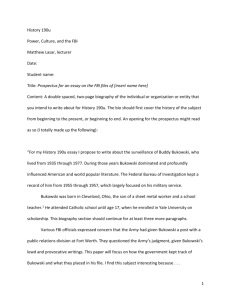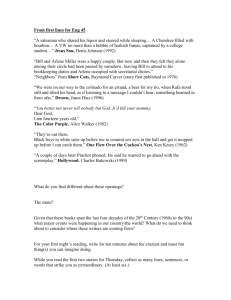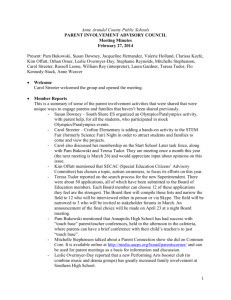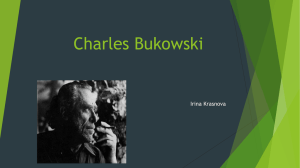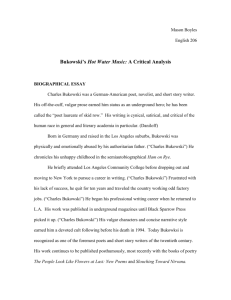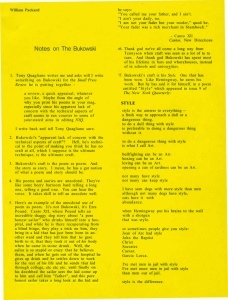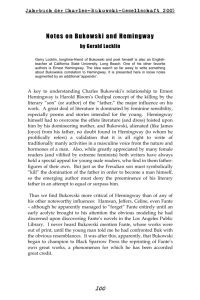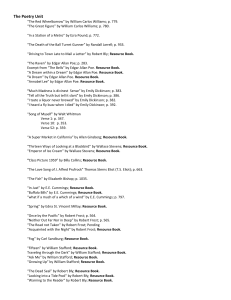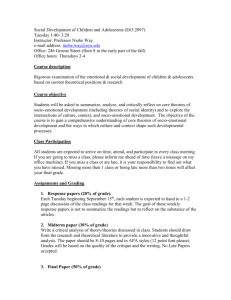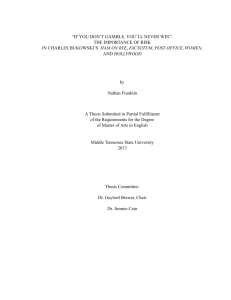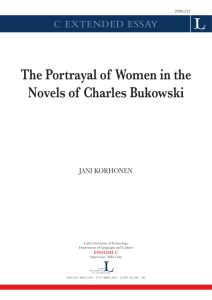“charles bukowski: poet on the edge” marks first
advertisement
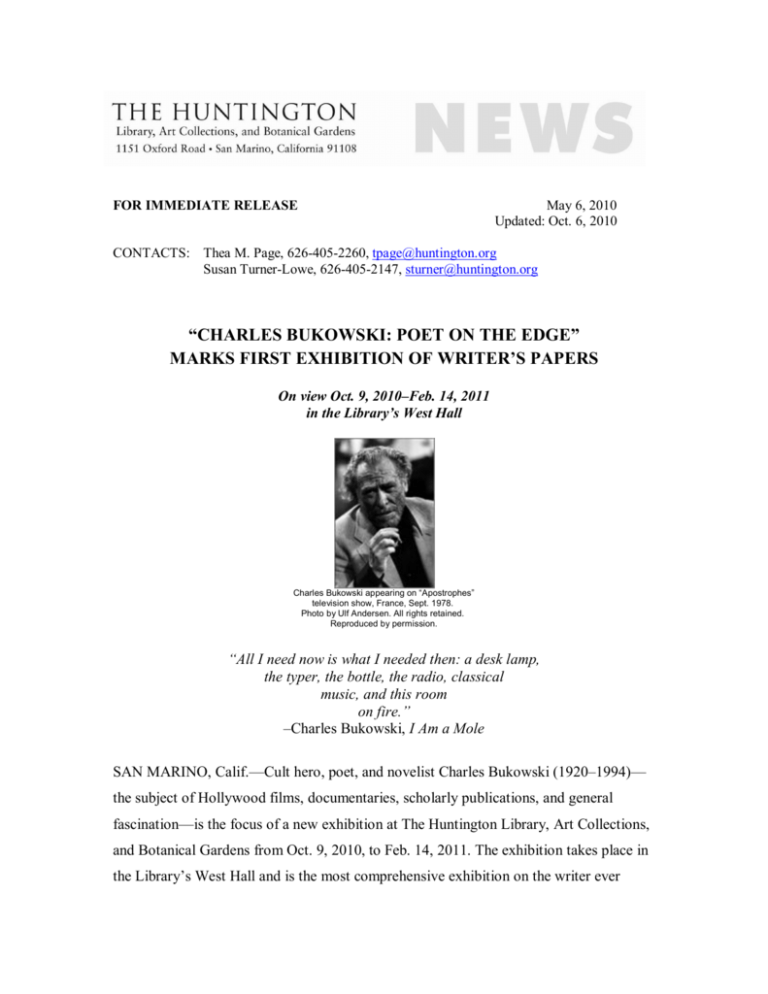
FOR IMMEDIATE RELEASE May 6, 2010 Updated: Oct. 6, 2010 CONTACTS: Thea M. Page, 626­405­2260, tpage@huntington.org Susan Turner­Lowe, 626­405­2147, sturner@huntington.org “CHARLES BUKOWSKI: POET ON THE EDGE” MARKS FIRST EXHIBITION OF WRITER’S PAPERS On view Oct. 9, 2010–Feb. 14, 2011 in the Library’s West Hall Charles Bukowski appearing on “Apostrophes” television show, France, Sept. 1978. Photo by Ulf Andersen. All rights retained. Reproduced by permission. “All I need now is what I needed then: a desk lamp, the typer, the bottle, the radio, classical music, and this room on fire.” –Charles Bukowski, I Am a Mole SAN MARINO, Calif.—Cult hero, poet, and novelist Charles Bukowski (1920–1994)— the subject of Hollywood films, documentaries, scholarly publications, and general fascination—is the focus of a new exhibition at The Huntington Library, Art Collections, and Botanical Gardens from Oct. 9, 2010, to Feb. 14, 2011. The exhibition takes place in the Library’s West Hall and is the most comprehensive exhibition on the writer ever 2 Bukowski: Poet on the Edge undertaken, showcasing more than 70 objects from Bukowski’s literary archive, which was donated to The Huntington by the writer’s widow, Linda Lee Bukowski, in 2006. Most of the material in the exhibition now resides at The Huntington; about a dozen items are on loan from Mrs. Bukowski. As a hard­edged voice that symbolized the experiences of the downtrodden living on the margins of society, Bukowski was an underground Los Angeles writer who has continued to gain literary prominence in the years following his death. “I open my newspaper, read the financial Section, get depressed, turn to the front Pages looking for murder, rape, robbery” –Charles Bukowski, The 7 Horse “Bukowski is one of the most original voices in 20 th ­century American literature,” says Sara “Sue” Hodson, curator of the exhibition and curator of literary manuscripts at The Huntington. “And his words resonate today as strongly as they did when first published. He wrote for common people because he came from common people, and that’s what you will experience when you come to this exhibition. He used a natural language that was highly charged at times, raw—and incredibly accessible—and continues to have great appeal to those who follow him.” The exhibition follows the writer from childhood into his early years as a struggling writer, and through later adulthood when, working with Black Sparrow Press, he became a cult figure with a significant international following. “He could be an irascible character in one moment, and then incredibly tender and reflective in another,” said Hodson, “and his writing is all of that. He was a complicated man who found great success as a writer against all odds.” Items in the exhibition include corrected typescripts of poetry; scarce editions of early magazines in which he was published; first editions and fine printings of his works from Black Sparrow Press and other publishers; his pen and ink drawings; photographs of him; broadside posters of poetry; correspondence; an oil portrait painted by artist John 3 Bukowski: Poet on the Edge Register (1936–1996); artists’ books, including one by Ken Price (b. 1935); a video recording of Bukowski at a reading; and his typewriter. Also included is a marked up racing form from 1977. “Bukowski frequented the Santa Anita racetrack, an experience that is reflected in his work,” Hodson said. “His writing is heavily infused by his vices and passions: wine, women, and gambling.” Often mistakenly associated with the Beat Generation writers, who broke onto the literary landscape in the 1950s, and from whom he disassociated himself, Bukowski was keenly influenced by the geography and atmosphere of his home city of Los Angeles. His works are strongly marked by the use of direct, blunt language and violent and sexual imagery. Bukowski drew extensively from his own life experience and emotion in his works, and he wrote with no apologies. Although he drank heavily and had a reputation as a lowlife, he was a prolific writer clearly dedicated to his craft. He finished more than 50 books and countless smaller pieces and poems that were often published in obscure literary journals. Bukowski’s novels include Post Office (1971); Factotum (1975); Women (1978); Ham on Rye (1982); Hollywood (1989); and Pulp (1994). His short stories include Notes of a Dirty Old Man (1969); South of No North: Stories of the Buried Life (1973); and Bring Me Your Love (1983). Flower, Fist, and Bestial Wail, published in 1959, was his first book of poetry; he would go on to write more than 40 others. The main character in many of his largely autobiographical poems and short stories is the down­and­out writer Henry Chinaski, who works at marginal jobs; gets drunk and hangs out with fellow losers, alcoholics, and drifters; and blows the rent at the race track. Biography Born in Germany to a German mother and American father stationed there in the service at the time, Bukowski came to the United States when he was a small child; the family settled in Los Angeles. His father beat him regularly, and he was ostracized as a youngster, partly because of a terrible case of acne that produced painful boils on his face and back. The combination of abuse and humiliation helped to mold him as a perpetual outsider. “He was essentially convinced of the hopelessness of humanity,” said Hodson. 4 Bukowski: Poet on the Edge In the semi­autobiographical Ham on Rye, Bukowski’s writes about standing outside the girls’ gymnasium, looking in at the high school prom under way, only to be chased off by a security guard. “It’s one heart­wrenching experience after another,” says Hodson. In 1939 Bukowski began attending Los Angeles City College, dropping out at the beginning of World War II and moving to New York to become a writer. By 1946, defeated by a collection of rejection slips, he set aside his writing aspirations. He fell into a decade­long drinking binge that took him all over the United States and left him with a bleeding ulcer. Back in Los Angeles, as he recovered, Bukowski began to write again— and to take on dead­end jobs. These included stints as a truck driver, gas station attendant, and Red Cross orderly. He was employed in a dog biscuit factory and slaughterhouse. For more than 10 years, however, Bukowski worked as a mail carrier in a Los Angeles post office. It was during this time—from the ’50s into the ’60s—that Bukowski was published widely in underground newspapers, including Open City and L.A. Free Press. In 1966, John Martin, a fan of his writing, approached Bukowski and encouraged him to devote himself to writing fulltime. Buoyed by his modest success, he quit his job and managed to support himself solely through writing from them on. This was accomplished in part through the efforts of Martin, who created Black Sparrow Press in Santa Barbara, Calif., and subsequently published almost all of Bukowski’s work. Martin remained his publisher until the writer’s death. In the 1980s Bukowski wrote the screenplay for the critically acclaimed Hollywood movie Barfly (1987), which was based on his life at 24. By this time, his popularity had grown significantly in America, and he was revered by younger artists, including actor Sean Penn and rock musician Bono. Bukowski, then as now, has always attracted enormous popularity in Europe. He died of leukemia in 1994 in San Pedro, Calif., at the age of 74. Since his death, the fan base for Bukowski’s work continues to grow around the world. HarperCollins bought the rights to Bukowski’s work when Martin closed Black Sparrow in 2002 and continues to publish his work. At the same time, scholarship on Bukowski has flourished as his writing is more widely embraced by traditional literary circles. 5 Bukowski: Poet on the Edge Related Programs The events below are free, open to the public, and take place in Friends’ Hall at The Huntington. Oct. 27, 7:30 p.m. ­ “Bukowski Aloud.” An evening of readings from the works of Charles Bukowski. Linda Lee Bukowski will be on hand along with special guest participants. Patt Morrison, Los Angeles Times columnist and KPCC radio host, will lead the conversation. Tickets required due to limited space. Call 800­838­3006 or visit www.brownpapertickets.com for tickets. Nov. 15, 7:30 p.m. ­ Born Into This. A screening of the documentary film about Charles Bukowski, by John Dullaghan. The filmmaker will introduce the documentary and answer questions following the screening. No reservations required. # # # [EDITOR’S NOTE: High­resolution digital images available on request for publicity use.] About The Huntington The Huntington Library, Art Collections, and Botanical Gardens is a collections­based research and educational institution serving scholars and the general public. More information about The Huntington can be found online at www.huntington.org. Visitor information The Huntington is located at 1151 Oxford Rd., San Marino, Calif., 12 miles from downtown Los Angeles. It is open to the public Monday, Wednesday, Thursday, and Friday from noon to 4:30 p.m.; and Saturday, Sunday, and Monday holidays from 10:30 a.m. to 4:30 p.m. Summer hours (Memorial Day through Labor Day) are 10:30 a.m. to 4:30 p.m. Closed Tuesdays and major holidays. Admission on weekdays: $15 adults, $12 seniors (65+), $10 students (ages 12–18 or with full­time student I.D.), $6 youth (ages 5–11), free for children under 5. Group rate $11 per person for groups of 15 or more. Members are admitted free. Admission on weekends and Monday holidays: $20 adults, $15 seniors, $10 students, $6 youth, free for children under 5. Group rate $14 per person for groups of 15 or more. Members are admitted free. Admission is free to all visitors on the first Thursday of each month with advance tickets. Information: 626­405­ 2100 or www.huntington.org.
